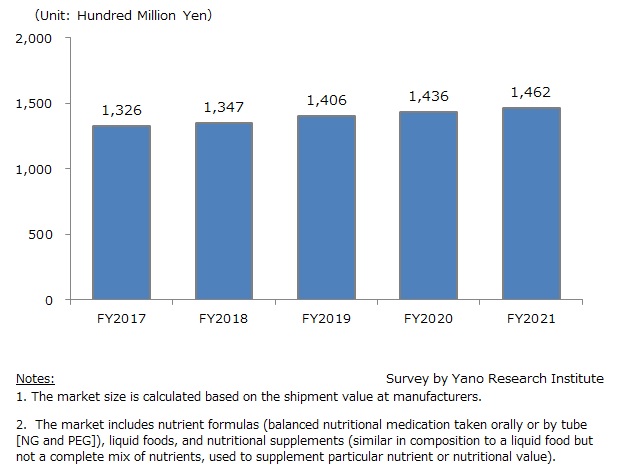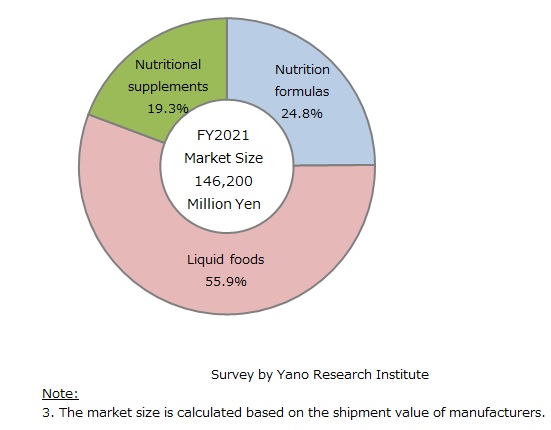No.3167
Nutrition Formulas, Liquid Foods, and Nutrition Supplements in Japan: Key Research Findings 2022
Market Size of Nutrition Formulas, Liquid Foods, and Nutrition Supplement Foods for FY2021 Grew Steadily to 146,200 Million Yen, 101.9% of Preceding Fiscal Year
Yano Research Institute (the President, Takashi Mizukoshi) has conducted a survey on the domestic market of nutrient formulas, liquid foods, and nutritional supplements, and has found out the trends by segment, the trends of market players, and future perspectives.


Market Overview
The market size of nutrition formulas, liquid foods, and nutrition supplements for FY2021 is estimated at 146,200 million yen, 101.9% of the preceding fiscal year. In view of the market by composition ratio, the nutrition formulas market grew to 36,300 million yen (103.2% on year-on-year basis), the liquid foods market attained 81,700 million yen (100.7%), and the nutrition replenishment foods market rose to 28,200 billion yen (103.2%). As the nutrition formulas prescribed by hospitals and pharmacies are covered by the National Medical Insurance, the use of nutrient formulas is increasing steadily among homecare patients. Demand for liquid foods is growing as well because the cost of liquid foods as hospital food of dietary treatment for inpatients and persons admitted at elderly facilities is also covered (mostly) by the national insurance. Use of nutritional supplementary foods is growing increasingly at hospitals, elderly facilities, and homecare as a method of avoiding undernutrition among elderlies. Propelled by the increase of senior population and the “Smart Life Project” led by the Ministry of Health, Labor and Welfare, the market is expanding continually.
*Translator’s note: Under the framework of National Medical Insurance, an insured person (patient) pays only the “standard meal expenses” of the actual cost of “meals as dietary treatment”, and the amount in excess is paid by the insurer (Health Insurance Association).
Noteworthy Topics
Market Expansion with Various Packaging Adapting to Application & Needs
Manufacturers of nutrient formulas, liquid foods, and nutritional supplements have developed a wide variety of products. By application, they developed products for specific medical condition, such as kidney failure, hepatic impairment, immune deficiency, and chronic respiratory failure, as well as for patients that had undergone PEG (Percutaneous Endoscopic Gastrostomy) procedure. In terms of packaging, they developed soft (squeeze) bags and other various container types. Progress is also observed to meet the needs of additional micronutrients and dietary fiber, better taste, and modified texture. Moreover, they are expanding the product range by adding more forms, such as those that can be eaten as smaller meals or nutritious snacks, those with higher calories, and slurry-type.
Speaking of the product packaging, the most common form for small-sized high-calorie liquid food is a 200ml brick carton. Meanwhile, nutrient formulas taken orally or by tube at hospitals and elderly facilities comes mostly in 1,000ml feeding bags.
Patients and the elderly people may lose their appetite when consuming liquid food repeatedly. To encourage patients and the elderly to eat well, makers have been improving the flavor of the liquid foods to make them more appetizing and producing them in smaller portion such as 200kcal/125 ml paper boxes. On the other hand, makers of “nutritionally balanced supplementary drinks” are changing brick packs to cups, and are competing for shelf space at drugstores and supermarkets. Demand for the liquid foods in cups is expected to increase among home care patients and the elderly.
Future Outlook
Coverage by the National Medical Insurance has prompted the use of nutrition formulas for homecare and the use of liquid foods dietary treatment for hospital inpatients and persons admitted to elderly facilities.
Against the background of growing senior population and continuance of insurance coverage for nutrient formulas, nutrition formulas are becoming major in the field of homecare. The market growth is driven by the development of products with high calories in small servings, the semi-solid format for PEG tubing, the nutrient formulas that are suitable for long-term use, and ONS (Oral Nutritional Supplements) with better taste. With drug price revisions, the market is forecasted to grow marginally. In homecare, ONS products anticipates major growth in particular.
Meanwhile, the liquid food market has declined moderately since the announcement of revision of the medical fee in March 2016, which led to the reduction of the use of commercially available enteral nutrition as inpatient dietary treatment. This is because the total cost of inpatient meals as dietary treatment fell roughly by 10%, influenced by the revision of the medical fee that made dietary treatment using thickened liquid diet no longer eligible for the a “special meal addition” (premium). Furthermore, intensified price competition has stunted the market growth by value. Nevertheless, the rise in demand for liquid foods as "complementary food" and new products like jelly cups are expected to make up for these losses. The liquid food market is projected to grow at an annual rate of 1 to 2% hereafter.
The demand for nutritional supplements is forecasted to grow mainly in the field of homecare. By increasing recognition of the product usefulness among seniors at homecare and their families, the market is expected to grow approximately by 3% hereafter.
Research Outline
2.Research Object: Manufacturers of nutrition formulas, liquid foods, and nutrition supplements
3.Research Methogology: Face-to-face interviews by our expert researchers (including online interviews), survey via telephone, and literature research
What are Nutrition Formulas, Liquid Foods, and Nutrition Supplements?
In this survey, “nutrition formulas” refer to nutritionally complete formulas that are taken by mouth or by tube feeding (via nasogastric tubes or PEG tubes), which are classified as pharmaceutical drugs. “Liquid foods” refer to liquid, semi-solid or solid foods containing a balanced mixture of energy, macronutrients, minerals, vitamins, etc. as well as liquid foods for the patients of specific illnesses (liquid foods high in calories). The “nutrition supplements” indicate foods that are similar in composition to liquid foods for seniors or patients, which supplement a specific nutrient or nutritional value of a food (but not nutritionally complete formulas). The market size is calculated based on the shipment value of manufacturers.
<Products and Services in the Market>
Nutrient formulas, liquid foods, and nutritional supplements
Published Report
Contact Us
The copyright and all other rights pertaining to this report belong to Yano Research Institute.
Please contact our PR team when quoting the report contents for the purpose other than media coverage.
Depending on the purpose of using our report, we may ask you to present your sentences for confirmation beforehand.